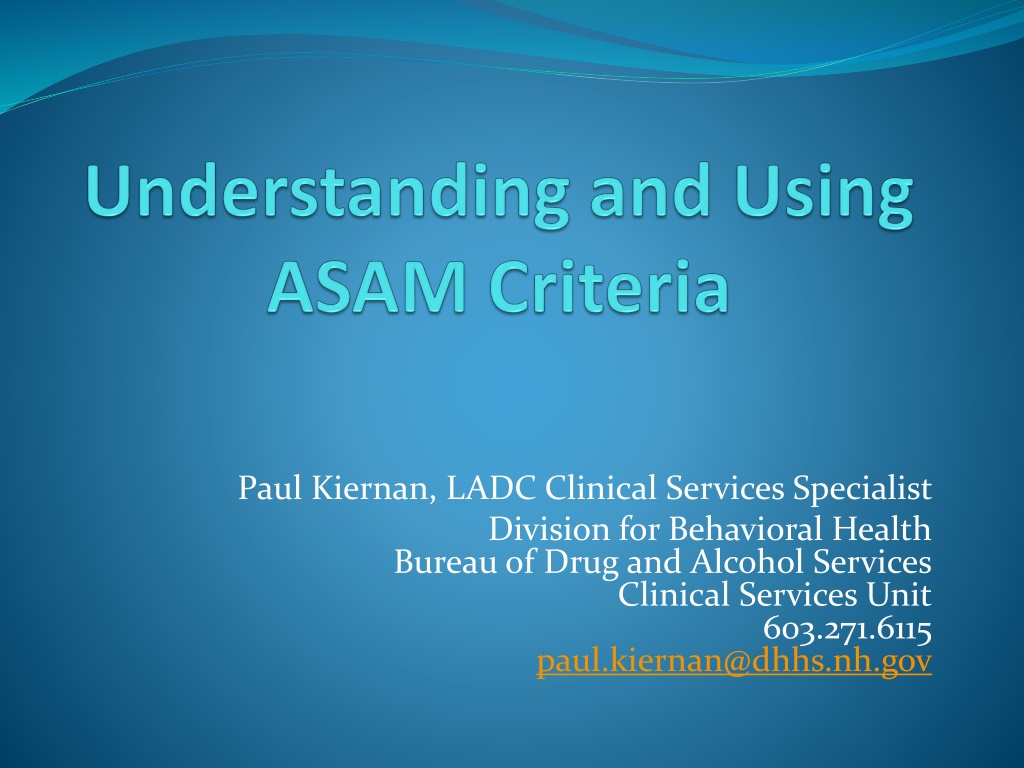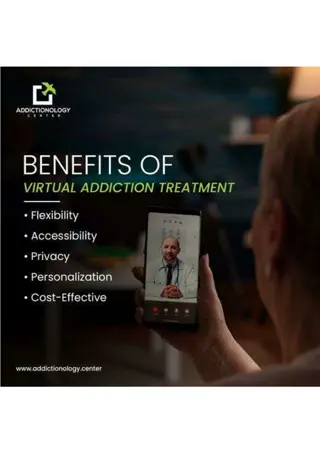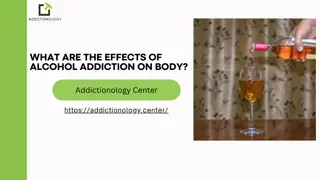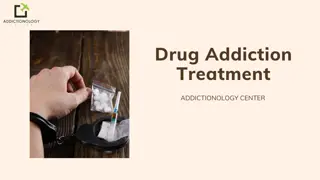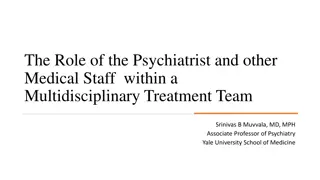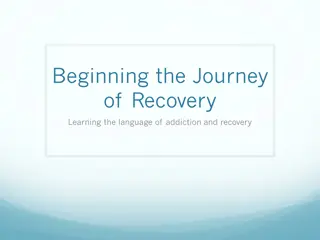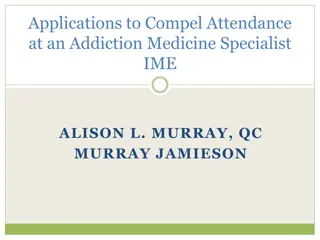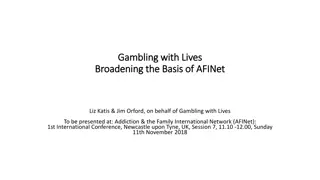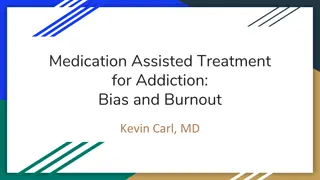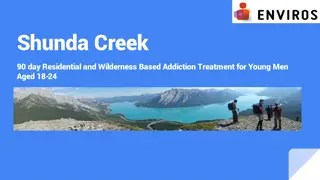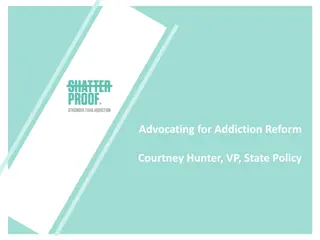Evolution of Addiction Treatment Approaches
The evolution of addiction treatment approaches highlights a shift from traditional inpatient models to a continuum of care. Changes in language and perception emphasize person-centered terminology. Understanding the historical context of insurance coverage and treatment durations, such as the significance of the 28-day model, sheds light on the development of more effective and individualized treatment strategies.
Download Presentation

Please find below an Image/Link to download the presentation.
The content on the website is provided AS IS for your information and personal use only. It may not be sold, licensed, or shared on other websites without obtaining consent from the author.If you encounter any issues during the download, it is possible that the publisher has removed the file from their server.
You are allowed to download the files provided on this website for personal or commercial use, subject to the condition that they are used lawfully. All files are the property of their respective owners.
The content on the website is provided AS IS for your information and personal use only. It may not be sold, licensed, or shared on other websites without obtaining consent from the author.
E N D
Presentation Transcript
Paul Kiernan, LADC Clinical Services Specialist Division for Behavioral Health Bureau of Drug and Alcohol Services Clinical Services Unit 603.271.6115 paul.kiernan@dhhs.nh.gov
The language that we use influences the way we think - Steven Pinker Incorrect term Preferred Term Addict, Alcoholic, Abuser, User, Junkie, Drug Seeker Person experiencing an alcohol/drug problem Person with a substance use disorder Recovering Addict Person in recovery Substance Abuse Substance Use, Substance Misuse Clean or Dirty Drug Screen Negative screen, substance-free, positive screen Replacement or Substitution Therapy Medication assisted treatment, medication
Why 28 days? Insurance Companies more open to treatment because of better understanding of addiction. Soldiers returning from Vietnam with SUD s. Insurance companies agreed to pay for up to 4 weeks of treatment. 4 weeks X 7 days = 28 days THAT S IT!!!!
A change In approaches to Addiction treatment Late 1980 s Early 1990 s More evidence in controlled outcome studies concluding no significant advantages to inpatient treatment Less willingness for reimbursement by insurance More focus on continuum of care model Began looking at more paths to recovery Moving away from One size Fits all model
American Society of Addiction Medicine Patient driven lengths of stay Non program/curriculum driven treatment Discharge begins at intake Continuum of care versus graduating treatment Complete dimensional assessment Continuing assessment
Adolescent levels of care maintaining transparency with regard to confidentiality limitations. The need for adolescent specific assessment methodologies. Withdrawal Management services are bundled into levels of care IOP services are 6 hours per week and suggested to be no longer than 2 hours per session Efforts should be made for minimal disruption into school/family
ASAM Dimensions Acute Intoxication and/or Withdrawal Potential 1. 2. Biomedical Conditions and Complications 3. Emotional, Behavioral, or Cognitive Conditions and Complications 4. Readiness to Change 5. Relapse, Continued Use, or Continued Problem Potential 6. Recovery/Living Environment
Dimension 1: Acute Intoxication or Withdrawal Potential Assessment considerations: Risks associated with the patients current level of Intoxication or withdrawal. Is the person intoxicated and planning to drive/bike? Substance use History How much, how often, how, and how long Current withdrawal symptoms, withdrawal history CIWA, COWS Score Assessment of multidimensional interaction Consider Patient for Withdrawal management services
Dimension 2: Biomedical Conditions and Complications Assessment Considerations Current Physical Illness Chronic medical conditions Pregnancy Multidimensional interaction (special attention to dimension 1)
Dimension 3: Emotional, Behavioral, or Cognitive Conditions and Complication Assessment Considerations Current emotional, behavioral, or cognitive conditions that could interfere with Treatment Chronic conditions Relation of Symptoms to SUD Mental health history Treatment history TBI History* Monitor Symptoms Multidimensional Interaction
Dimension 4: Readiness to Change Assessment Considerations Mental Health and SUD assessment. Patient s level of awareness of their relationship between negative consequences and substance use. Patients readiness, willingness, ability to change addictive behavior. Patient s Goals for Treatment. Multidimensional interaction.
Dimension 5: Relapse, Continued Use, Continued Problem Potential Assessment Considerations Both SUD and mental health disorder assessment Strengths, coping skills, ability to manage craving, impulse control Understanding relapse versus continued use Relapse History Thoughts, internal dialogue preceding relapse Relapse does not mean a higher level of care. Continued use could mean lower level of care Patients awareness of cues/triggers Multidimensional interaction
Dimension 6: Recovery Environment Assessment Considerations Both SUD and mental health disorder assessment Threats to patients safety or engagement in treatment Resources available to help with a successful recovery Transportation, childcare, housing or employment issues Mandates that influence treatment motivation Spirituality Multidimensional assessment
ASAM Levels of Care Level 0.5 Early Intervention Level 1 - Outpatient Services Level 2 - Intensive Outpatient/Partial Hospitalization Services Level 3 Residential/Inpatient Services Level 4 - Medically-Managed Intensive Inpatient Services
Early Intervention Level 0.5 For individuals with known risk of developing a SUD Not sufficient information for Diagnosis Provides education, screening, identifies risk factors, helps individuals see consequences of continued use.
Outpatient Services Level 1 Organized services in a wide variety of settings Professionally directed evaluation treatment and recovery service Regularly scheduled meetings
Intensive Outpatient Level 2.1 Organized services delivered day or evening hours to accommodate work, childcare schedules Provides Patients the opportunity to apply skills learned as they learn them. Regular consultation with psychiatric, medical and medication management 9 or more hours a week for adult, 6 or more hours a week for adolescent
Partial Hospitalization Services Level 2.5 Direct access to psychiatric, medical, and lab services when warranted Provides 20 or more hours/week of services
Clinically-Managed Low Intensity Residential Level 3.1 Transitional living/Halfway House 24 hour structure with available trained staff Minimum of 5 Hours of clinical services per week
Clinically Managed Population Specific High Intensity Residential Services Level 3.3 Adult Level of Care only 24 Hour care with trained professionals to stabilize imminent risk Less intense to accommodate the needs of patients unable to benefit from a more intense application of treatment Typically for patients with developmental disabilities or TBI
Clinically-Managed High Intensity Residential - Level 3.5 Clinically-Managed Medium Intensity Residential 24 Hour care with trained professionals to stabilize imminent risk Patients must be able to tolerate and benefit from intense milieu or therapeutic community
Medically-Monitored Intensive Inpatient Treatment Level 3.7 Adult Criteria 24/7 nursing care and physicians available. Similar to level 3.5 but with in-house access to acute medical or psychiatric care. For individuals with significant problems in Dimension 1,2, or 3.
Medically Managed Intensive Inpatient Services Level 4 24/7 nursing care and daily physician care for severe, unstable problems in dimension 1,2,3 Counseling service are available. Although a SUD diagnosis is needed, patients acute needs are addressed.
Opioid Treatment Services (OTS) Not a separate level of care. Additional services that can be integrated or bundled into current levels of care
New Versus Old Patient Driven Program Driven Patient centered treatment plans. Length of stay based on patients needs, progress with treatment goals. Discharge begins at intake, looking at next level of care in a continuum. Continued care based on clinical assessment Program centered treatment plans. Length of stay fixed, based on curriculum. Discharge is done after patient graduates . Fixed length of stay
References Mee-Lee, David (2013). The ASAM Criteria: Treatment Criteria for Addictive, Substance-Related and Co- Occurring Conditions. Chevy Chase, MD: American Society of Addiction Medicine, Inc.
